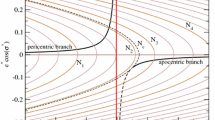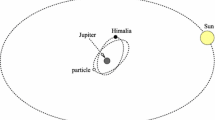Abstract
We report results from long term numerical integrations and analytical studies of particular orbits in the circular restricted three-body problem. These are mostly high-inclination trajectories in 1 : 1 resonance starting at or near the triangular Lagrangian L5 point. In some intervals of inclination these orbits have short Lyapunov times, from 100 to a few hundred periods, yet the osculating semi-major axis shows only relatively small fluctuations and there are no escapes from the 1 : 1 resonance. The eccentricity of these chaotic orbits varies in an erratic manner, some of the orbits becoming temporarily almost rectilinear. Similarly the inclination experiences large variations due to the conservation of the Jacobi constant. We studied such orbits for up to 109 periods in two cases and for 106 periods in all others, for inclinations varying from 0° to 180°. Thus our integrations extend from thousands to 10 million Lyapunov times without escapes of the massless particle. Since there are no zero-velocity curves restricting the motion this opens questions concerning the reason for the persistence of the 1 : 1 resonant motion. In the theory sections we consider the mechanism responsible for the observed behavior. We derive the averaged 1 : 1 resonance disturbing function, to second order in eccentricity, to calculate a critical inclination found in the numerical experiment, and examine motion close to this inclination. The cause of the chaos observed in the numerical experiments appears to be the emergence of saddle points in the averaged disturbing potential. We determine the location of several such saddle points in the (φ, ω) plane, with φ being the mean longitude difference and ω the argument of pericentre. Some of the saddle points are illustrated with the aid of contour plots of the disturbing function. Motion close to these saddles is sensitive to initial conditions, thus causing chaos.
Similar content being viewed by others
References
Beaugá, C. and Roig, F.: 2001, ‘A semianalytical model for the Trojan asteroids: proper elements and families’, Icarus 153, 391–415.
Christou, A.: 2000, ‘A numerical survey of transient co-orbitals of the terrestrial planets’, Icarus 144, 1–20.
Dvorak, R. and Tsiganis, K.: 2000, ‘Why do Trojan ASCS (not) escape?’, Celest. Mech. & Dyn. Astr. 78, 125–136.
Érdi, B.: 1988, ‘Long periodic perturbations of Trojan asteroids’, Celest. Mech. & Dyn. Astr. 43, 303–308.
Innanen, K. and Mikkola, S.: 1989, ‘Studies on solar system dynamics. I. The stability of Saturnian Trojans’, AJ 97, 900–908.
Kozai, Y.: 1962, ‘Secular perturbations of asteroids with high inclination and eccentricity’, AJ 67, 591–598.
Lecar, M., Franklin, F. and Murison, M.: 1992, ‘On predicting long-term orbital stability: a relation between the Lyapunov time and sudden orbital transitions’, Astron. J. 104, 1230–1236.
Marzari, F. and Scholl, H.: 2000, ‘The role of secular resonances in the history of trojans’, Icarus 146, 232–239.
Mikkola, S. and Innanen, K.: 1990, ‘Studies on solar system dynamics. II. The stability of earth's Trojans’, AJ 100, 290–293.
Mikkola, S. and Innanen, K.: 1992, ‘A numerical exploration of the evolution of Trojan-type asteroidal orbits’, AJ 104, 1641–1649.
Mikkola, S. and Innanen, K.: 1994, ‘On the stability of Martian Trojans’, AJ 107, 1879–1884.
Mikkola, S. and Innanen, K.: 1995, ‘On the stability of high inclination Trojans’, EM&P 71, 195–198.
Mikkola, S. and Innanen, K.: 1997, ‘Orbital stability of planetary quasi-satellites’. In: J. Henrard and R. Dvorak (eds), The Dynamical Behaviour of Our Planetary System, Kluwer Academic Publishers, Dordrecht, 1997.
Mikkola, S. and Tanikawa, K.: 1999, ‘Explicit symplectic algorithms for time-transformed Hamiltonians’, Celest. Mech. & Dyn. Astr. 74, 287–295.
Mikkola, S., Palmer, P. and Hashida, Y.: 2002, ‘An implementation of the logarithmic Hamiltonian method for artificial satellite orbit determination’, Celest. Mech. & Dyn. Astr. 82, 391–411.
Milani, A. and Nobili, A.: 1992, ‘An example of stable chaos in the Solar System’, Nature 358, 569–571.
Milani, A., Nobili, A. and Kne\(\tilde z\)ević, Z.: 1997, ‘Stable chaos in the asteroid belt’, Icarus 125, 13–31.
Morais, M. H. M.: 2001, ‘Hamiltonian formulation of the secular theory for Trojan-type motion’, A&A 369, 677.
Morbidelli, A. and Froeschlè, C.: 1996, ‘On the relationship between Lyapunov times and macroscopic instability times’, Celest. Mech. & Dyn. Astr. 63, 227–239.
Murray, C. and Dermott, S.: 1999, Solar System Dynamics, Cambridge, 1999.
Namouni, F.: 1999, ‘Secular interactions of coorbital objects’, Icarus 137, 293–314.
Namouni, F., Cristou, A. A. and Murray, C. D.: 1999, ‘Coorbital dynamics at large eccentricity and inclination’, Phys. Rev. Lett. 83, 2506–2509.
Nesvorný, D., Thomas, F., Ferraz-Mello, S. and Morbidelli, A.: 2002, ‘A perturbative treatment of the co-orbital motion’, Celest. Mech. & Dyn. Astr. 82, 323–361.
Pilat-Lohinger, E., Dvorak, R. and Burger, Ch.: 1999, ‘Trojans in stable chaotic motion’, Celest. Mech. & Dyn. Astr. 73, 117–126.
Preto, M. and Tremaine, S.: 1999, ‘A class of symplectic integrators with adaptive timestep for separable Hamiltonian systems’, Astron. J. 118, 2532–2541.
Rauch, K. P. and Holman, M.: 1999, ‘Dynamical chaos in the Wisdom-Holman integrator: origins and solution’, Astron. J. 117, 1087–1102.
Tsiganis, K., Varvoglis, H. and Hadjidemetriou, J. D.: 2000, ‘Stable chaos in the 12:7 mean motion resonance and its relation to the stickiness effect’, Icarus 146, 240–252.
Tsiganis, K., Varvoglis, H. and Hadjidemetriou, J. D.: 2002, ‘Stable chaos in high-order Jovian resonances’, Icarus 155, 454–474.
Wisdom, J. and Holman, M.: 1991, ‘Symplectic maps for the N-body problem’, Astron. J. 102, 1520–1538.
Zhang, S.-P. and Innanen, K.: 1988, ‘The motion of planetary triangular Lagrange particles with high inclinations’, Astron. J. 96, 1995–2002.
Author information
Authors and Affiliations
Rights and permissions
About this article
Cite this article
Brasser, R., Heggie, D.C. & Mikkola, S. One to One Resonance at High Inclination. Celestial Mechanics and Dynamical Astronomy 88, 123–152 (2004). https://doi.org/10.1023/B:CELE.0000016810.65114.17
Issue Date:
DOI: https://doi.org/10.1023/B:CELE.0000016810.65114.17




